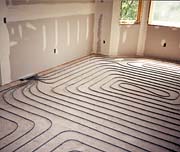
Board members of the Radiant Panel Association (RPA) recently met to focus on the future of their association and the radiant industry at large. Lawrence Drake, executive director of the RPA, discussed some new initiatives, as well as industry trends, withThe News.
One of the new ideas being pursued is installer certification. Said Drake, “The board is working on a skeleton proposal which they’ll present to an action committee in January at our semi-annual meeting.” That action committee will then review and flesh out the program.
“We should have a final proposal by May of next year at our annual conference.” The membership will also provide input. “And then, hopefully, shortly thereafter we can implement it,” stated Drake.
“I think that the industry is definitely ready for it,” he noted. “We did a survey of our members and certification was rated pretty high.”
The association is planning on using the Internet and distance learning for its certification program. “It’s difficult to get people to come to classes if it’s not nearby,” he remarked, “and then you only have them for a day or a couple of days.” With the Internet, installers looking to be certified can learn any time and at their own pace.
The RPA is also talking to other trade organizations about certification and how to dovetail their efforts.
TEST It, Rate It
Product testing and rating is another proposal on the table. The association is investigating ways to rate systems, for example, comparing systems installed in gypsum to aluminum plate staple-up systems. Drake said, “What we need to do is rate that floor sandwich as a system so that there’s some good apples-to-apples comparisons.”He added that his organization is watching the American Society of Heating, Refrigerating and Air-Conditioning Engineers (ASHRAE) study that’s going on right now where Kansas State University is doing this type of testing. The RPA is also working on a floor covering directory listing floors recommended by manufacturers for use with radiant systems.
A trend identified by Drake and the board is that the traditional tiered structure of the industry is changing. “The tiered system that we’ve seen in the past is getting more and more blurred as time goes on,” he said. “There’s a lot more blurring of the lines between a contractor and distributor and manufacturer and sales rep.”
Regarding cooling with radiant, he asserted, “Radiant floor cooling has very limited application. I don’t think we’ll see big growth in that market. Where we might see some increase is in radiant ceiling cooling.” At one time this was used quite a bit, so there might be some renewed interest from that aspect.
More likely, Drake opined, we’ll see more integration between radiant heating systems and standard air conditioning systems. “We see that kind of integration taking place.”
The Internet has been influential in getting the word out about radiant. Half of the calls the RPA gets are from people finding out about radiant systems on the web.
STILL GROWING
The industry is still seeing solid growth. “As long as we have a strong building economy, our growth will continue, if not accelerate,” said Drake.Last year, however, radiant’s growth was reduced compared to recent years. The industry had been up 25% to 30% per year; in 1999, it was up 14%. But the problem is not that the market is shrinking. “The problem is that we don’t have the people to put in the equipment,” he explained. “We’re finding a real shortage of installers out there.”
The association’s education program is working to bring in more installers. The Internet will be used to try to attract more people. The organization will also be more aggressively addressing hvac contractors, showing them the advantages of taking on radiant.
Drake stated that contractors on both the air side and the water side need to look at all available approaches and consider the best ways to keep customers comfortable. Contractors need to step out of their “comfort zone, so to speak,” and check out the other side’s solutions.
The RPA has an installation guideline but now is seeking to create an actual standard and get it accepted by code officials. Drake noted that radiant is not addressed very significantly in current mechanical codes.
A new challenge for the industry is that the do-it-yourself market is now trying to install radiant systems. Contractors report that some are creating problem systems.
“We expect to see the do-it-yourself market continue to develop,” he said. Some contractor members don’t like this. But he personally encourages contractors to work with do-it-yourselfers to help them get it right and possibly oversee the job.
“I think that our industry needs to develop an answer or solution for the do-it-yourselfer just to protect our radiant heating reputation.”
Sidebar: Radiant’s Hot Both East and West
As the radiant heating industry continues to grow, the Radiant Panel Association (RPA) provides information to professionals and consumers across the country. Membership in the association has been increasing as well.More than 50% of the inquiries come from the Northeast. Not surprisingly, about 57% of the RPA’s members come from this region.
New York is the No. 1 state in number of inquiries. On the other coast, California is No. 2, followed closely by Illinois. In a virtual tie for fourth place are Pennsylvania, Michigan, and New Jersey.
There have been few significant changes since 1998. Most of the Great Lakes states have seen faster growth than the rest of the nation. Interest in the Southeast, especially Tennessee and Georgia, has been steadily rising.
Publication date: 10/30/2000


Report Abusive Comment